-
 Description: 16mo, 20.2 x 13.5 cm, bound in blue buckram with gilt lettering to spine, in dust jacket lettered to front, spine, back, and flaps, price 13s6d net uncut; front has red letters “BGS” in the bottom right (probably stands for Book Grading Service); 1st edition. Title-page: THE | QUIET AMERICAN | by | GRAHAM GREENE | {publisher’s device} |—| WILLIAM HEINEMANN LTD | MELBOURNE :: LONDON :: TORONTO || T.p. verso: FIRST PUBLISHED 1955 | PRINTED IN GREAT BRITAIN | AT THE WINDMILL PRESS | KINGSWOOD, SURREY || Collation: [A]-H16; total 128 leaves. Pagination: [8] [2] 3-247 [248]; total 256 pages. Contributors: Graham Greene (British, 1904 – 1991) William Henry Heinemann (Jewish-British, 1863 – 1920)
Description: 16mo, 20.2 x 13.5 cm, bound in blue buckram with gilt lettering to spine, in dust jacket lettered to front, spine, back, and flaps, price 13s6d net uncut; front has red letters “BGS” in the bottom right (probably stands for Book Grading Service); 1st edition. Title-page: THE | QUIET AMERICAN | by | GRAHAM GREENE | {publisher’s device} |—| WILLIAM HEINEMANN LTD | MELBOURNE :: LONDON :: TORONTO || T.p. verso: FIRST PUBLISHED 1955 | PRINTED IN GREAT BRITAIN | AT THE WINDMILL PRESS | KINGSWOOD, SURREY || Collation: [A]-H16; total 128 leaves. Pagination: [8] [2] 3-247 [248]; total 256 pages. Contributors: Graham Greene (British, 1904 – 1991) William Henry Heinemann (Jewish-British, 1863 – 1920) -
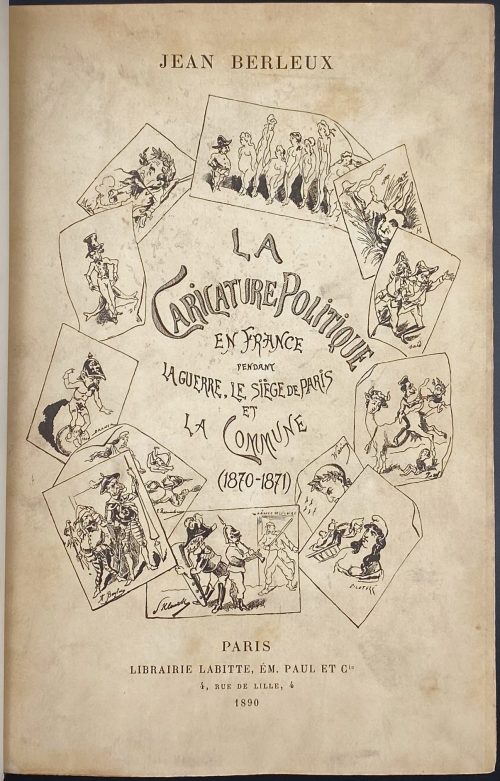 Hardcover, 25.2 x 17 cm, quarter burgundy shagreen with raised bands and gilt lettering to spine over turkish marbled boards and endpapers, publisher’s wrappers preserved. Title-page: JEAN BERLEUX | LA | CARICATURE POLITIQUE | EN FRANCE | PENDANT LA GUERRE, LE SIÈGE DE PARIS | ET LA COMMUNE | (1870–1871) | {vignette} | PARIS | LABITTE, ÉM. PAUL ET Cie | LIBRAIRES DE LA BIBLIOTHÈQUE NATIONALE | 4, RUE DE LILLE, 4 | – | 1890 || Collation: 4to; π8 1-274 282, plates within collation; total 118 leaves. Pagination: [i-ix] x-xvi, [1] 2-217 (printed 317) [3], total 236 pages, profusely illustrated, incl. in-text and full-page b/w ils, all within pagination. Condition: Good, scattering foxing, pencil marks. Contributors: Maurice Quentin-Bauchart [pseud. Jean Berleux] (French, 1857 – 1910) – author. Georges Chamerot (French, 1845 – 1922) – printer, president of the 'Chambre syndicale des imprimeurs typographes', married to Claudie Viardot (French, 1852 – 1914) in 1874 – printer. Labitte, Ém. Paul et Cie (Paris) – publisher, Adolphe Labitte (French, 1832 – 1882); Émile Paul (French, 1847 – ?). Another copy in poor condition: LIB-1653.2016, and another, a modern reprint: LIB-0814.2015.
Hardcover, 25.2 x 17 cm, quarter burgundy shagreen with raised bands and gilt lettering to spine over turkish marbled boards and endpapers, publisher’s wrappers preserved. Title-page: JEAN BERLEUX | LA | CARICATURE POLITIQUE | EN FRANCE | PENDANT LA GUERRE, LE SIÈGE DE PARIS | ET LA COMMUNE | (1870–1871) | {vignette} | PARIS | LABITTE, ÉM. PAUL ET Cie | LIBRAIRES DE LA BIBLIOTHÈQUE NATIONALE | 4, RUE DE LILLE, 4 | – | 1890 || Collation: 4to; π8 1-274 282, plates within collation; total 118 leaves. Pagination: [i-ix] x-xvi, [1] 2-217 (printed 317) [3], total 236 pages, profusely illustrated, incl. in-text and full-page b/w ils, all within pagination. Condition: Good, scattering foxing, pencil marks. Contributors: Maurice Quentin-Bauchart [pseud. Jean Berleux] (French, 1857 – 1910) – author. Georges Chamerot (French, 1845 – 1922) – printer, president of the 'Chambre syndicale des imprimeurs typographes', married to Claudie Viardot (French, 1852 – 1914) in 1874 – printer. Labitte, Ém. Paul et Cie (Paris) – publisher, Adolphe Labitte (French, 1832 – 1882); Émile Paul (French, 1847 – ?). Another copy in poor condition: LIB-1653.2016, and another, a modern reprint: LIB-0814.2015. -
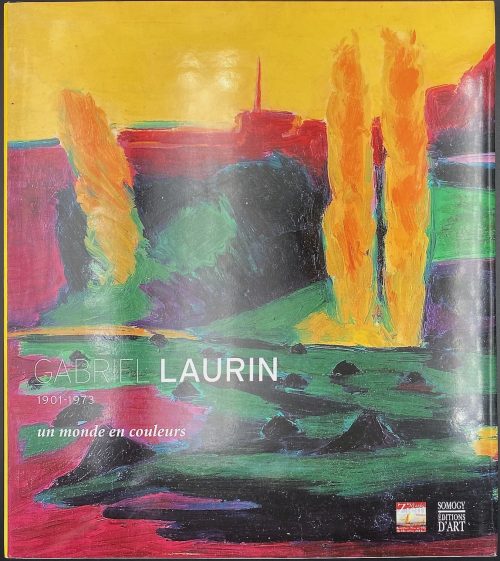 Hardcover volume, 28.5 x 25.5 cm, green lettered boards, pictorial dust jacket, pp.: [1-13] 14-143 [144], ils., inset: double-sheet 29.7 x 21 cm, “Exposition du 4 novembre 2006 au 4 février 2007”. Published on the occasion of the exhibition "Gabriel Laurin d'Aix (1901-1973)" held at the Musée Ziem, Martigues, Nov. 3, 2006 — Feb. 4, 2007. Title-page: GABRIEL LAURIN | un monde en couleurs | 1901-1973 | Sous la direction de Gérard Fabre | Texte de Jeanine Warnod | {publishers devices} || Contributors: Gabriel Laurin (French, 1901 – 1973) Jeanine Warnod (French, b. 1921) Gérard Fabre (French, b. 1963)
Hardcover volume, 28.5 x 25.5 cm, green lettered boards, pictorial dust jacket, pp.: [1-13] 14-143 [144], ils., inset: double-sheet 29.7 x 21 cm, “Exposition du 4 novembre 2006 au 4 février 2007”. Published on the occasion of the exhibition "Gabriel Laurin d'Aix (1901-1973)" held at the Musée Ziem, Martigues, Nov. 3, 2006 — Feb. 4, 2007. Title-page: GABRIEL LAURIN | un monde en couleurs | 1901-1973 | Sous la direction de Gérard Fabre | Texte de Jeanine Warnod | {publishers devices} || Contributors: Gabriel Laurin (French, 1901 – 1973) Jeanine Warnod (French, b. 1921) Gérard Fabre (French, b. 1963) -
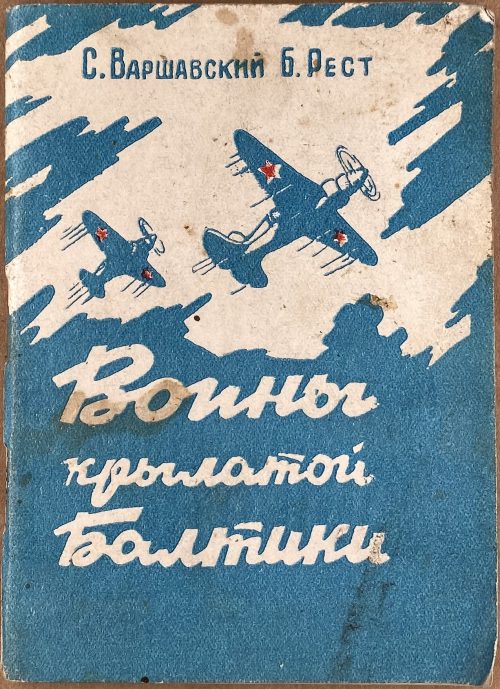 Small paperback, 12.3 x 9 cm, pictorial turquoise wrappers, pp.: [2] 3-52 [4], ils., total 56 pp., incl. contents, colophon and last blank; collated 8vo: 1-38 44, total 28 leaves; print run 25,000 copies. Title-page (framed): С. ВАРШАВСКИЙ и Б. РЕСТ | ВОИНЫ | КРЫЛАТОЙ | БАЛТИКИ | 1941 | Государственное издательство | “Искусство” | Ленинград • Москва || Contributors: Сергей Петрович Варшавский [Sergei Varshavsky] (Russian-Jewish, 1906 – 1980) – author. Б. Рест (Юлий Исаакович Шапиро (Russian-Jewish, 1907 – 1984) – author. Лев Самойлович Самойлов (Russian, 1918 – 1988) – artist.
Small paperback, 12.3 x 9 cm, pictorial turquoise wrappers, pp.: [2] 3-52 [4], ils., total 56 pp., incl. contents, colophon and last blank; collated 8vo: 1-38 44, total 28 leaves; print run 25,000 copies. Title-page (framed): С. ВАРШАВСКИЙ и Б. РЕСТ | ВОИНЫ | КРЫЛАТОЙ | БАЛТИКИ | 1941 | Государственное издательство | “Искусство” | Ленинград • Москва || Contributors: Сергей Петрович Варшавский [Sergei Varshavsky] (Russian-Jewish, 1906 – 1980) – author. Б. Рест (Юлий Исаакович Шапиро (Russian-Jewish, 1907 – 1984) – author. Лев Самойлович Самойлов (Russian, 1918 – 1988) – artist.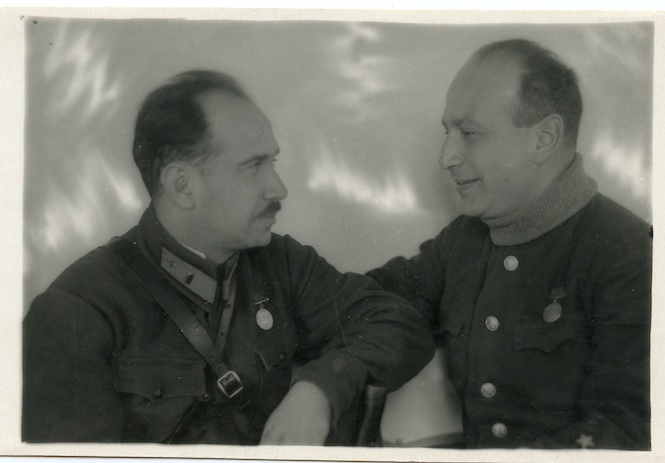
-
 Artist: Utagawa Toyokuni I [歌川豊国] (1769–1825). Pubisher: Enshūya Matabei (遠州屋又兵衛) (c. 1768 – 1881), seal name: Enmata [ 遠又]. Signed: Toyokuni ga [豊国画]. Date-aratame censor seal: 未改, Bunsei 6 (1823). Size: uchiwa-e; 233 x 262 mm. Ref: Israel Goldman. Japanese Prints, Paintings and Books / Catalogue 28, 2022: № 14.
Artist: Utagawa Toyokuni I [歌川豊国] (1769–1825). Pubisher: Enshūya Matabei (遠州屋又兵衛) (c. 1768 – 1881), seal name: Enmata [ 遠又]. Signed: Toyokuni ga [豊国画]. Date-aratame censor seal: 未改, Bunsei 6 (1823). Size: uchiwa-e; 233 x 262 mm. Ref: Israel Goldman. Japanese Prints, Paintings and Books / Catalogue 28, 2022: № 14. -
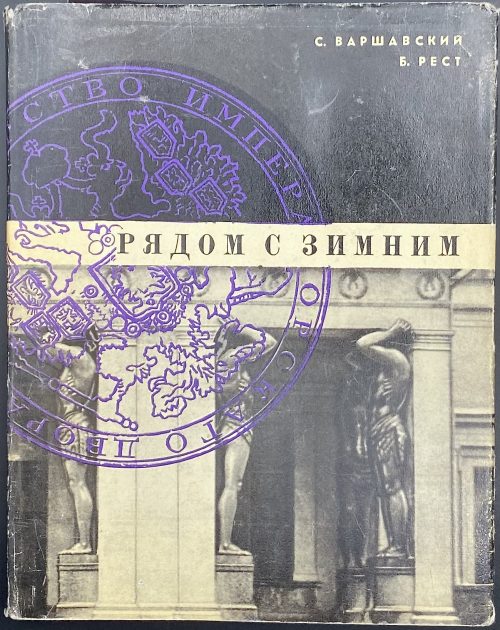 Hardcover volume, 22.2 x 17.5 cm, bound in green cloth, black lettering to spine, in a pictorial dust jacket, pp.: [1-4] 5-151 [152], ils. Title-page: С. ВАРШАВСКИЙ • Б. РЕСТ | РЯДОМ С ЗИМНИМ | «СОВЕТСКИЙ ХУДОЖНИК» | ЛЕНИНГРАД • 1969 || Half-title: Из истории Государственного Эрмитажа | ЭРМИТАЖ ПЕРЕД ОКТЯБРЕМ || Print run: 25,000 copies. Contributors: Sergei Petrovich Varshavsky [Сергей Петрович Варшавский] (Jewish-Russian, 1906 – 1980) – author. B. Rest [Б. Рест; Юлий Исаакович Шапиро] (Jewish-Russian, fl. 1940 – 1980) – author.
Hardcover volume, 22.2 x 17.5 cm, bound in green cloth, black lettering to spine, in a pictorial dust jacket, pp.: [1-4] 5-151 [152], ils. Title-page: С. ВАРШАВСКИЙ • Б. РЕСТ | РЯДОМ С ЗИМНИМ | «СОВЕТСКИЙ ХУДОЖНИК» | ЛЕНИНГРАД • 1969 || Half-title: Из истории Государственного Эрмитажа | ЭРМИТАЖ ПЕРЕД ОКТЯБРЕМ || Print run: 25,000 copies. Contributors: Sergei Petrovich Varshavsky [Сергей Петрович Варшавский] (Jewish-Russian, 1906 – 1980) – author. B. Rest [Б. Рест; Юлий Исаакович Шапиро] (Jewish-Russian, fl. 1940 – 1980) – author. -
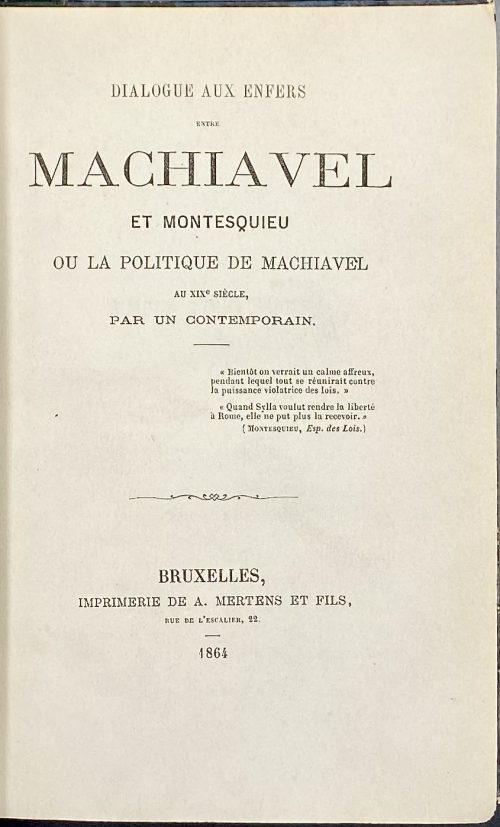 Title page: DIALOGUE AUX ENFERS | ENTRE | MACHIAVEL | ET MONTESQUIEU | OU LA POLITIQUE DE MACHIAVEL | AU XIXe SIÈCLE, | PAR UN CONTEMPORAIN. | {6 lines of citations} | ~ | BRUXELLES, | IMPRIMERIE DE A. MERTENS ET FILS, | RUE DE L’ESCALIER, 22. | – | 1864 || Description: 19 x 12.7 cm, quarter green morocco over blue marbled boards, spine with raised bands ruled in gilt, gilt fleurons in compartments, gilt lettering, marbled endpapers; three paper clippings laid in. Collation: 12mo; π5 1-2712 292; total 175 leaves. Pagination: [2] blank, [2] h.t, [2] t.p. [i] ii-iii [iv] [1] 2-337 [338] blank [2] errata]; total 350 pages. Contributors: Maurice Joly (French, 1829 – 1878) – author. Characters: Niccolò Machiavelli (Italian, 1469 – 1527) Charles Louis de Secondat, baron de La Brède et de Montesquieu (French, 1689 – 1755) The publication was funded by the author and smuggled into France. See other copies: LIB-2913.2021, LIB-1034.2016 and LIB-0460.2015. Other related objects: SVVP-0062.2021. Seller's description: [JOLY (Maurice)]: Dialogue aux enfers entre Machiavel et Montesquieu. Bruxelles, Mertens et fils, 1864 ; un volume in 12, demi-chagrin vert orné de l'époque. C'est dans ce livre que Joly écrit, au prétexte d'une discussion philosophique et politique, comment Napoléon III, selon lui, a manipulé les milieux économiques, la presse, l'opinion publique, les syndicats, les milieux ouvriers, le peuple, etc., pour établir un pouvoir politique fort, ce qui lui valut un séjour de 15 mois à la prison Sainte-Pélagie à Paris.
Title page: DIALOGUE AUX ENFERS | ENTRE | MACHIAVEL | ET MONTESQUIEU | OU LA POLITIQUE DE MACHIAVEL | AU XIXe SIÈCLE, | PAR UN CONTEMPORAIN. | {6 lines of citations} | ~ | BRUXELLES, | IMPRIMERIE DE A. MERTENS ET FILS, | RUE DE L’ESCALIER, 22. | – | 1864 || Description: 19 x 12.7 cm, quarter green morocco over blue marbled boards, spine with raised bands ruled in gilt, gilt fleurons in compartments, gilt lettering, marbled endpapers; three paper clippings laid in. Collation: 12mo; π5 1-2712 292; total 175 leaves. Pagination: [2] blank, [2] h.t, [2] t.p. [i] ii-iii [iv] [1] 2-337 [338] blank [2] errata]; total 350 pages. Contributors: Maurice Joly (French, 1829 – 1878) – author. Characters: Niccolò Machiavelli (Italian, 1469 – 1527) Charles Louis de Secondat, baron de La Brède et de Montesquieu (French, 1689 – 1755) The publication was funded by the author and smuggled into France. See other copies: LIB-2913.2021, LIB-1034.2016 and LIB-0460.2015. Other related objects: SVVP-0062.2021. Seller's description: [JOLY (Maurice)]: Dialogue aux enfers entre Machiavel et Montesquieu. Bruxelles, Mertens et fils, 1864 ; un volume in 12, demi-chagrin vert orné de l'époque. C'est dans ce livre que Joly écrit, au prétexte d'une discussion philosophique et politique, comment Napoléon III, selon lui, a manipulé les milieux économiques, la presse, l'opinion publique, les syndicats, les milieux ouvriers, le peuple, etc., pour établir un pouvoir politique fort, ce qui lui valut un séjour de 15 mois à la prison Sainte-Pélagie à Paris. -
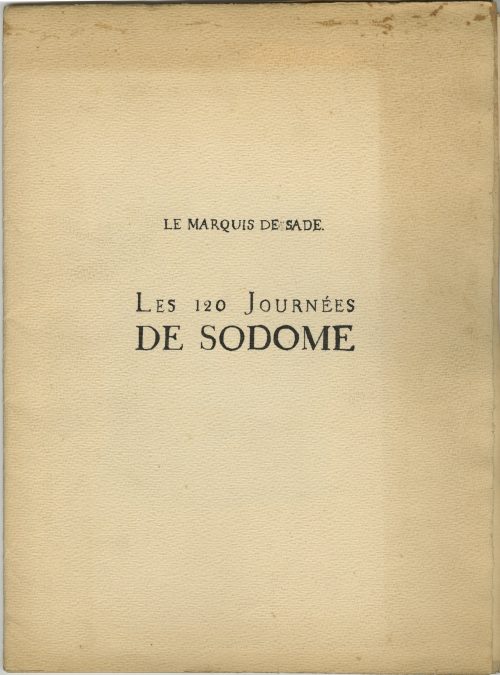 A set of sixteen pen and ink wash drawings on wove paper by an anonymous artist after lithographs by André Collot, who illustrated the 1935 edition of Les 120 journées de Sodome, ou l’école du libertinage, by the Marquis de Sade, based on the original autograph manuscript by Maurice Heine. The set is housed in a rough texture paper folder with an ink manuscript to the front: LE MARQUIS DE SADE. | Les 120 journées | DE SODOME || Size: 340 x 250 mm (folder); 335 x 252 (sheet); approx. 160 x 110 (image). Contributors: Donatien Alphonse François, Marquis de Sade (French, 1740 – 1814) – author. Maurice Heine (French, 1884 – 1940) – publisher of the original Les 120 journées. André Collot (French, 1897-1976) – artist of the original illustrations for the 1935 edition. This set was produced by an anonymous artist from the bohemian Montmartre, Montparnasse, or the School of Fine Arts, close to the booksellers', by demand of an excentric bibliophile, at about the same time. Collot's illustrations can be found at www.honesterotica.com.
A set of sixteen pen and ink wash drawings on wove paper by an anonymous artist after lithographs by André Collot, who illustrated the 1935 edition of Les 120 journées de Sodome, ou l’école du libertinage, by the Marquis de Sade, based on the original autograph manuscript by Maurice Heine. The set is housed in a rough texture paper folder with an ink manuscript to the front: LE MARQUIS DE SADE. | Les 120 journées | DE SODOME || Size: 340 x 250 mm (folder); 335 x 252 (sheet); approx. 160 x 110 (image). Contributors: Donatien Alphonse François, Marquis de Sade (French, 1740 – 1814) – author. Maurice Heine (French, 1884 – 1940) – publisher of the original Les 120 journées. André Collot (French, 1897-1976) – artist of the original illustrations for the 1935 edition. This set was produced by an anonymous artist from the bohemian Montmartre, Montparnasse, or the School of Fine Arts, close to the booksellers', by demand of an excentric bibliophile, at about the same time. Collot's illustrations can be found at www.honesterotica.com. -
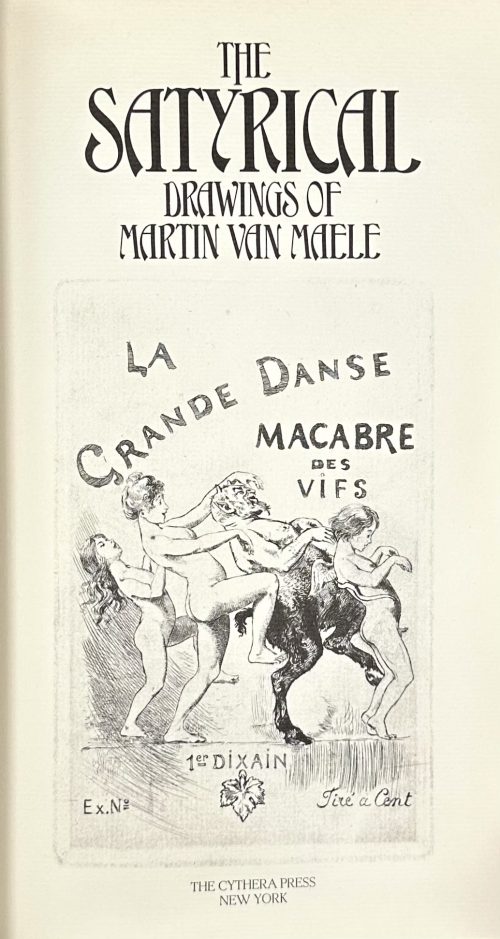 Hardcover volume 28.5 x 19 cm, bound in brown wrinkled buckram with framed gilt lettering and fleurons to front and framed gilt lettering to spine, in a pictorial dust jacket, green and yellow floral diaper endpapers, printed on laid paper, bottom and outer margins untrimmed. Collation: Eight unnumbered pages of text in English, incl. bibliography, plus 45 unnumbered leaves of plates (photomechanical) with captions in French. Facsimile reproduction of the published in ca. 1907-1908 ‘La grande danse macabre des vifs’, which can be loosely translated as ‘The great strange dance of life’ or ‘The great dance of death by the living’. Title-page: THE | SATYRICAL | DRAWINGS OF | MARTIN VAN MAELE | {vignette} | THE CYTHERA PRESS NEW YORK || SELECTED BIBLIOGRAPHY OF MAURICE FRANÇOIS ALFRED MARTIN VAN MAËLE [MARTIN VAN MAËLE] (FRENCH, 1863 – 1926) (ANONYMOUS). Sweet Seventeen. — Paris: Charles Carrington, 1910. ANSON, MARGUERITE. Une Société de flagellantes. — Paris: Charles Carrington. 1902. 31 illustrations by Van Maele and A. Lambrecht. Translation of The Merry Order of St. Bridget. APULEUS, LUCIUS. Les Métamorphoses, ou l’âne d'or. — Paris: Charles Carrington, 1905. Translation of The Golden Ass. The same Van Maele plates were probably used by the publisher for his English translation of the same work (Paris, 1904). ARETINO, PIETRO. Les Dialogues. 2 volumes. — Paris: Au Cabinet du Livre. 1927. Only the textual illustrations are by Van Maele. The other plates are by Viset. This is believed to be the Iast book that Van Maele illustrated. DESROIX, JACQUES. La Gynécocratte. — Paris: Charles Carrington, 1902. Translation of Gynecocracy. FRANCE, ANATOLE. Thaïs. — Paris: Charles Carrington, 1901. English translation. JUSANGE. PIERRE DE. La Comtesse au foulet. — Paris: Collection des Orties Blanches, s.d. SACHER-MASOCH. La Vénus a la fourrure. — Paris: Charles Carrington, 1902. VAN MAELE, MARTIN. La Grande Danse macabre des vifs. — Paris: Charles Carrington, ca. 1907-8. VERLAINE, PAUL. La Trilogie érotique. — Paris: Charles Carrington, 1907. Reprinted, Brussels, 1931. The original edition is rare. VILLIOT, JEAN DE. Camille et moi. — Paris: Charles Carrington, 1904. Translation of Frank and I. VILLIOT, JEAN DE. Dix-sept ans. — Paris: Librairie des Bibliophiles Parisiens, Charles Carrington, 1905. Translation of Sweet Seventeen. VILLIOT, JEAN DE. La Flagellation amoureuse. — Paris: Charles Carrington. 1904. VILLIOT, JEAN DE. La Flagellation des femmes en Allemagne. — Paris: Charles Carrington. 1901. Translation of Nell in Bridewell. VILLIOT, JEAN DE. Volées de bois vert. — Paris: Librairie des Bibliophiles Parisiens, Charles Carrington, 1905. (ANONYMOUS): Flèches de plomb. BAUDELAIRE, CHARLES. Les Fleurs du mal. BERANGER. Chansons érotiques. CHODER LOS DE LACLOS. Les Liaisons dangereuses. — Paris: 1908. GAUTIER, THEOPHILE. Lettre au Président. HARAUCOURT. Légende des sexes. — Paris, 1908. MICHELET, JULES. La Sorcière. — Paris, 1911.
Hardcover volume 28.5 x 19 cm, bound in brown wrinkled buckram with framed gilt lettering and fleurons to front and framed gilt lettering to spine, in a pictorial dust jacket, green and yellow floral diaper endpapers, printed on laid paper, bottom and outer margins untrimmed. Collation: Eight unnumbered pages of text in English, incl. bibliography, plus 45 unnumbered leaves of plates (photomechanical) with captions in French. Facsimile reproduction of the published in ca. 1907-1908 ‘La grande danse macabre des vifs’, which can be loosely translated as ‘The great strange dance of life’ or ‘The great dance of death by the living’. Title-page: THE | SATYRICAL | DRAWINGS OF | MARTIN VAN MAELE | {vignette} | THE CYTHERA PRESS NEW YORK || SELECTED BIBLIOGRAPHY OF MAURICE FRANÇOIS ALFRED MARTIN VAN MAËLE [MARTIN VAN MAËLE] (FRENCH, 1863 – 1926) (ANONYMOUS). Sweet Seventeen. — Paris: Charles Carrington, 1910. ANSON, MARGUERITE. Une Société de flagellantes. — Paris: Charles Carrington. 1902. 31 illustrations by Van Maele and A. Lambrecht. Translation of The Merry Order of St. Bridget. APULEUS, LUCIUS. Les Métamorphoses, ou l’âne d'or. — Paris: Charles Carrington, 1905. Translation of The Golden Ass. The same Van Maele plates were probably used by the publisher for his English translation of the same work (Paris, 1904). ARETINO, PIETRO. Les Dialogues. 2 volumes. — Paris: Au Cabinet du Livre. 1927. Only the textual illustrations are by Van Maele. The other plates are by Viset. This is believed to be the Iast book that Van Maele illustrated. DESROIX, JACQUES. La Gynécocratte. — Paris: Charles Carrington, 1902. Translation of Gynecocracy. FRANCE, ANATOLE. Thaïs. — Paris: Charles Carrington, 1901. English translation. JUSANGE. PIERRE DE. La Comtesse au foulet. — Paris: Collection des Orties Blanches, s.d. SACHER-MASOCH. La Vénus a la fourrure. — Paris: Charles Carrington, 1902. VAN MAELE, MARTIN. La Grande Danse macabre des vifs. — Paris: Charles Carrington, ca. 1907-8. VERLAINE, PAUL. La Trilogie érotique. — Paris: Charles Carrington, 1907. Reprinted, Brussels, 1931. The original edition is rare. VILLIOT, JEAN DE. Camille et moi. — Paris: Charles Carrington, 1904. Translation of Frank and I. VILLIOT, JEAN DE. Dix-sept ans. — Paris: Librairie des Bibliophiles Parisiens, Charles Carrington, 1905. Translation of Sweet Seventeen. VILLIOT, JEAN DE. La Flagellation amoureuse. — Paris: Charles Carrington. 1904. VILLIOT, JEAN DE. La Flagellation des femmes en Allemagne. — Paris: Charles Carrington. 1901. Translation of Nell in Bridewell. VILLIOT, JEAN DE. Volées de bois vert. — Paris: Librairie des Bibliophiles Parisiens, Charles Carrington, 1905. (ANONYMOUS): Flèches de plomb. BAUDELAIRE, CHARLES. Les Fleurs du mal. BERANGER. Chansons érotiques. CHODER LOS DE LACLOS. Les Liaisons dangereuses. — Paris: 1908. GAUTIER, THEOPHILE. Lettre au Président. HARAUCOURT. Légende des sexes. — Paris, 1908. MICHELET, JULES. La Sorcière. — Paris, 1911. -
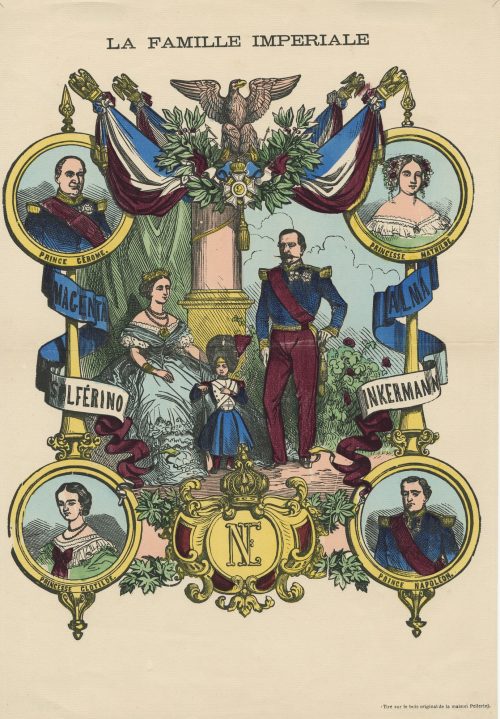 Hand-coloured woodcut on laid paper, 422 x 294 mm; black ink stamp “5307” to reverse, centrefold. Top center: "LA FAMILLE IMPERIALE"; Bottom right: "(Tire sur le bois original de maison Pellerin)". Image: Napoléon III, Empress Eugenie, and Prince Imperial Louis-Napoléon as a child surrounded with four lettered medallions: “PRINCE GÉROME”, “PRINCESSE MATHILDE”, “PRINCESSE CLOTILDE”, and “PRINCE NAPOLÉON”; ribbons lettered: “MAGENTA”, SOLFERINO”, “ALMA”, and “INKERMANN” around heraldic spears; coat of arms with imperial monogram between Princesse Clotilde and Prince Napoléon. Publisher/printer: Jean Charles Pellerin (French, 1756 – 1836). Battle of Magenta : 4 June 1859, against the Austrians. Battle of Solferino : 24 June 1859, against the Austrians. Battle of the Alma : 20 September 1854 (Crimean War) Battle of Inkerman : 5 November 1854 (Crimean War) Characters: Napoleon III [Charles-Louis Napoléon Bonaparte] (French, 1808 – 1873) Eugénie de Montijo [L'impératrice Eugénie] (Spanish-French, 1826 – 1920) Napoléon, Prince Imperial (Napoléon Eugène Louis Jean Joseph Bonaparte] (French, 1856 – 1879) Napoléon-Jérôme Bonaparte [Prince Jérôme] (French, 1822 – 1891) Mathilde Bonaparte [Princess Mathilde] (French, 1820 – 1904) Marie-Clotilde de Savoie [Princesse Clotilde] (French, 1843 – 1911)
Hand-coloured woodcut on laid paper, 422 x 294 mm; black ink stamp “5307” to reverse, centrefold. Top center: "LA FAMILLE IMPERIALE"; Bottom right: "(Tire sur le bois original de maison Pellerin)". Image: Napoléon III, Empress Eugenie, and Prince Imperial Louis-Napoléon as a child surrounded with four lettered medallions: “PRINCE GÉROME”, “PRINCESSE MATHILDE”, “PRINCESSE CLOTILDE”, and “PRINCE NAPOLÉON”; ribbons lettered: “MAGENTA”, SOLFERINO”, “ALMA”, and “INKERMANN” around heraldic spears; coat of arms with imperial monogram between Princesse Clotilde and Prince Napoléon. Publisher/printer: Jean Charles Pellerin (French, 1756 – 1836). Battle of Magenta : 4 June 1859, against the Austrians. Battle of Solferino : 24 June 1859, against the Austrians. Battle of the Alma : 20 September 1854 (Crimean War) Battle of Inkerman : 5 November 1854 (Crimean War) Characters: Napoleon III [Charles-Louis Napoléon Bonaparte] (French, 1808 – 1873) Eugénie de Montijo [L'impératrice Eugénie] (Spanish-French, 1826 – 1920) Napoléon, Prince Imperial (Napoléon Eugène Louis Jean Joseph Bonaparte] (French, 1856 – 1879) Napoléon-Jérôme Bonaparte [Prince Jérôme] (French, 1822 – 1891) Mathilde Bonaparte [Princess Mathilde] (French, 1820 – 1904) Marie-Clotilde de Savoie [Princesse Clotilde] (French, 1843 – 1911) -
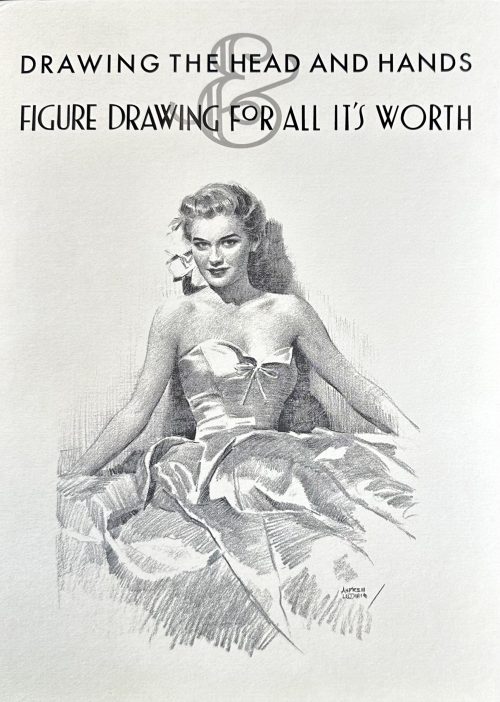 Cardboard box 32 x 23.7 cm with lettering and vignette to front, lettering to spine, and Loomis facsimile and Titan publisher's barcode label to back.
Cardboard box 32 x 23.7 cm with lettering and vignette to front, lettering to spine, and Loomis facsimile and Titan publisher's barcode label to back.- Title-page: Drawing | THE HEAD AND HANDS | BY | ANDREW LOOMIS | {vignette} ||
- Title-page: FIGURE DRAWING | FOR ALL IT'S WORTH | ANDREW LOOMIS ||
-
 Iron tsuba of mokko form decorated with encircled family crests in low relief carving; niku from 3.0 mm in the centre to 4.0 mm at rim and full 1 mm raised uchikaeshi-mimi. Nobuie [信家] signature (hanare-mei) to the left of nakago-ana; on the reverse, to the right of nakago-ana, the inscription reads “62”, which may be how old the master was at the age of making the tsuba. Pewter or lead plugged hitsuana. In a wooden box, in a custom pouch. Size: H: 80 mm, W: 75, Th(c): 3.1 mm, Th(r): 4.0 mm Weight: 103.5 g
Iron tsuba of mokko form decorated with encircled family crests in low relief carving; niku from 3.0 mm in the centre to 4.0 mm at rim and full 1 mm raised uchikaeshi-mimi. Nobuie [信家] signature (hanare-mei) to the left of nakago-ana; on the reverse, to the right of nakago-ana, the inscription reads “62”, which may be how old the master was at the age of making the tsuba. Pewter or lead plugged hitsuana. In a wooden box, in a custom pouch. Size: H: 80 mm, W: 75, Th(c): 3.1 mm, Th(r): 4.0 mm Weight: 103.5 gSigned: Nobuie [信家] / 62
Probably the work of Shodai Nobuie (c. 1580).
Tokubetsu hozon certificate № 2002993 of the N.B.T.H.K., dated January 15, 2016. NOBUIE TSUBA by Steve Waszak The iron tsuba made by the two early Nobuie masters are regarded as the greatest sword guards ever made across hundreds of years of Japanese history. Only a small handful of other smiths' names are even mentioned in the same breath as that of Nobuie. Despite the well-deserved fame of the Nobuie name, virtually nothing is known with certainty about the lives of the two men who made the pieces carrying this name. They are thought to have been men of Owari Province, with the Nidai Nobuie also spending time in Aki Province at the end of the Momoyama Period. Two Nobuie tsubako are recognized. The man whom most consider to have been the Shodai signed his sword guards with finer and more elegantly inscribed characters than the smith seen by most as the Nidai. The term used to describe the mei of the Shodai is "hanare-mei" or "ga-mei," while that used to characterize the signature of the Nidai is "futoji-mei" or "chikara-mei." These terms refer to the fineness and grace of the Shodai's signature and the relatively more powerfully inscribed characters of the Nidai's. The Shodai is thought to have lived during the Eiroku and Tensho eras in the latter part of the 16th century, while the Nidai's years are considered to have been from Tensho into the Genna era. This locates both smiths well within the Golden Age of tsuba artists -- the Momoyama Period. Nobuie tsuba are esteemed and celebrated for the extraordinary beauty of their iron. The combination of the forging of the metal, the surface treatment by tsuchime and yakite married to powerfully expressive carving, the masterful manipulation of form, mass and shape, and the colour and patina of the iron makes Nobuie sword guards not only unique in the world of tsuba, but the greatest of the great. The sword guard here is a Shodai-made masterwork, done in mokko-gata form, a shape the early Nobuie smiths mastered to a degree unmatched by any others. The expanding of the mass of the tsuba from the seppa-dai to the mimi, increasing by 50% from the centre of the guard to the rim, creates a sense of exploding energy, which is then contained by the uchikaeshi-mimi, yielding a lightning-in-a-bottle effect of captured energy. The hammering the master has employed to finish the surface is subtle and sensitive, achieving a resonant profundity, and the deep blue-black colour -- augmented by a lustrous patina -- leaves the tsuba to positively glow in one's hand. In this piece, Nobuie has used a motif of several kamon, or family crests, each carved only lightly on the surface in a loose ring around the nakago-ana. Due to the shallow depth of this carving, together with the tsuchime finish of the plate, the effect is to leave the kamon with a sort of weathered appearance, recalling the prime aesthetic values of sabi and wabi, which had great circulation in the Tea Culture so ascendant in the Momoyama years. However, the effects of sabi and wabi expressed in the treatment described above are amplified and deepened by the color and patina of the iron, thereby adding yet another aesthetic value -- yuugen -- which is linked with the abiding mystery of the universe and one more — mono no aware — which alludes to the pathos of life's experiences and transitory nature. In short, this Nobuie tsuba joins poetry with power and therein exemplifies the unrivalled brilliance of Nobuie workmanship. -
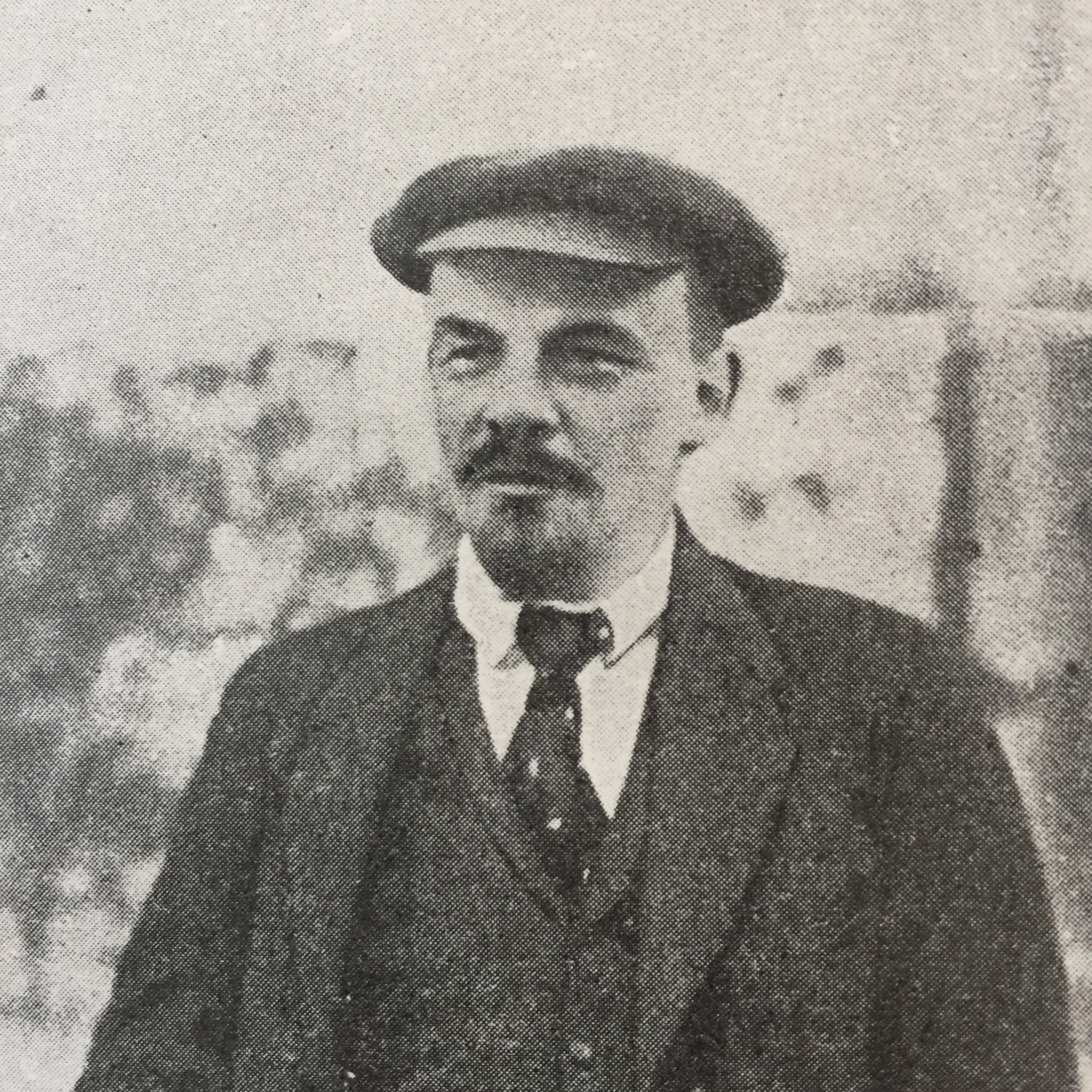
Каторга и ссылка. Историко-революционный вестник. Книга 8, № 1, 1924. Общество бывших политических каторжан и ссылно-поселенцев. Под общей редакцией Вл. Виленского (Сибирякова). Москва, 1924. Государственное издательство "Типография Печатный Двор", Ленинград. Тираж: 4,000 экз.
-
 Iron tsuba of round form decorated with inlay of four concentric rows of brass dots or nail heads (ten-zōgan) and a circular brass wire inlay inside the innermost row of dots. Copper sekigane. Muromachi period, 15th or 16th century. Unsigned. Ōnin school. Size: 87.9 x 87.8 x 2.2 mm. Ōnin school got its name from the Ōnin War (応仁の乱 - Ōnin no Ran) - a civil war that lasted 10 years (1467–1477) during the Muromachi period in Japan.
Iron tsuba of round form decorated with inlay of four concentric rows of brass dots or nail heads (ten-zōgan) and a circular brass wire inlay inside the innermost row of dots. Copper sekigane. Muromachi period, 15th or 16th century. Unsigned. Ōnin school. Size: 87.9 x 87.8 x 2.2 mm. Ōnin school got its name from the Ōnin War (応仁の乱 - Ōnin no Ran) - a civil war that lasted 10 years (1467–1477) during the Muromachi period in Japan. -
 Late 19th-century (1850-1870) Japanese export fan. This fan has a double leaf painted with a different design on either side. Ivory encrusted with gemstones and other materials. Subject matter such as women wearing kimono is also more typical of export than domestic products (V&A). Autumn theme on the reverse.
Late 19th-century (1850-1870) Japanese export fan. This fan has a double leaf painted with a different design on either side. Ivory encrusted with gemstones and other materials. Subject matter such as women wearing kimono is also more typical of export than domestic products (V&A). Autumn theme on the reverse. -
 Iron tsuba of oval form with design of iris and plank bridge (yatsubashi) in openwork (sukashi). Rounded cornered rim. Unsigned. Attributed to Jingo - 3rd generation Shimizu, 2nd generation Jingo (1691-1777) [M. Sesko, Genealogy..., p. 94]. Edo period: Late 18th century (Hohreki / Meiwa era). Height: 69.5 mm. Width: 65.2 mm. Rim thickness: 4.6 mm. Center thickness: 4.8 mm. Provenance: Sasano Masayuki Collection, № 251: "Shimizu. Third generation Jingo (died at 87 years of age in the sixth year of An-ei, 1777). The eight-section bridge with irises are arranged to create the design of 'yatsubashi'. The features are unique for the Shimizu school and show no influence of the Hirita, Nishigaki or Hayashi schools". The design visually resembles a butterfly. As described in Family Crests of Japan by Stone Bridge Press [Family Crests of Japan; Stone Bridge Press, Berkeley, CA, 2007], and also in Japanese Family Crests by Yuzuru Okada [Yuzuru Okada. Japanese Family Crests // Series: Tourist Library: 37. Board of tourist industry; Japanese Government Railways, - 1941], there is a special technique used in construction of family crests, called 'reshaping' by the former and 'reconstruction' by the latter: "reconstruction is realized when a motive has its general shape composed of the detail of entirely different motive as, for instance, the crest of a butterfly formed of pine-needles. [...] The fanciful and ingenious forms evolved in this way may be represented by the kasiwa-giri or 'oak-leaf-paulownia', the ogi-bisi or 'fan-lozenge', the matuba-zuru or 'pine-needle-crane', the omodaka-kotyo or 'water-plantain-butterfly', etc." In our case we can call the motif yatsubashi-chocho or 'Iris-and-Bridge—Butterfly'.
Iron tsuba of oval form with design of iris and plank bridge (yatsubashi) in openwork (sukashi). Rounded cornered rim. Unsigned. Attributed to Jingo - 3rd generation Shimizu, 2nd generation Jingo (1691-1777) [M. Sesko, Genealogy..., p. 94]. Edo period: Late 18th century (Hohreki / Meiwa era). Height: 69.5 mm. Width: 65.2 mm. Rim thickness: 4.6 mm. Center thickness: 4.8 mm. Provenance: Sasano Masayuki Collection, № 251: "Shimizu. Third generation Jingo (died at 87 years of age in the sixth year of An-ei, 1777). The eight-section bridge with irises are arranged to create the design of 'yatsubashi'. The features are unique for the Shimizu school and show no influence of the Hirita, Nishigaki or Hayashi schools". The design visually resembles a butterfly. As described in Family Crests of Japan by Stone Bridge Press [Family Crests of Japan; Stone Bridge Press, Berkeley, CA, 2007], and also in Japanese Family Crests by Yuzuru Okada [Yuzuru Okada. Japanese Family Crests // Series: Tourist Library: 37. Board of tourist industry; Japanese Government Railways, - 1941], there is a special technique used in construction of family crests, called 'reshaping' by the former and 'reconstruction' by the latter: "reconstruction is realized when a motive has its general shape composed of the detail of entirely different motive as, for instance, the crest of a butterfly formed of pine-needles. [...] The fanciful and ingenious forms evolved in this way may be represented by the kasiwa-giri or 'oak-leaf-paulownia', the ogi-bisi or 'fan-lozenge', the matuba-zuru or 'pine-needle-crane', the omodaka-kotyo or 'water-plantain-butterfly', etc." In our case we can call the motif yatsubashi-chocho or 'Iris-and-Bridge—Butterfly'. -
 Iron tsuba of oval form carved and inlaid in gold and copper with cormorant fisherman in disguise. Unsigned. Dimensions: 67.7 mm x 61.5 mm x 3.8 mm (at seppa-dai) Edo period: 18th century. "Since Nara period, Japanese fishermen in small boats have used cormorants (u) to catch river fish at night, binding the necks of the birds so that the fish are not swallowed. [...] The bird and the work it performs are symbols of selfless devotion to one's master and keen eyesight." - from Merrily Baird. Symbols of Japan. Thematic motifs in art and design. Rizzoli international publications, Inc., 2001; p. 104. See also TSU-0212 and TSU-0096
Iron tsuba of oval form carved and inlaid in gold and copper with cormorant fisherman in disguise. Unsigned. Dimensions: 67.7 mm x 61.5 mm x 3.8 mm (at seppa-dai) Edo period: 18th century. "Since Nara period, Japanese fishermen in small boats have used cormorants (u) to catch river fish at night, binding the necks of the birds so that the fish are not swallowed. [...] The bird and the work it performs are symbols of selfless devotion to one's master and keen eyesight." - from Merrily Baird. Symbols of Japan. Thematic motifs in art and design. Rizzoli international publications, Inc., 2001; p. 104. See also TSU-0212 and TSU-0096 -
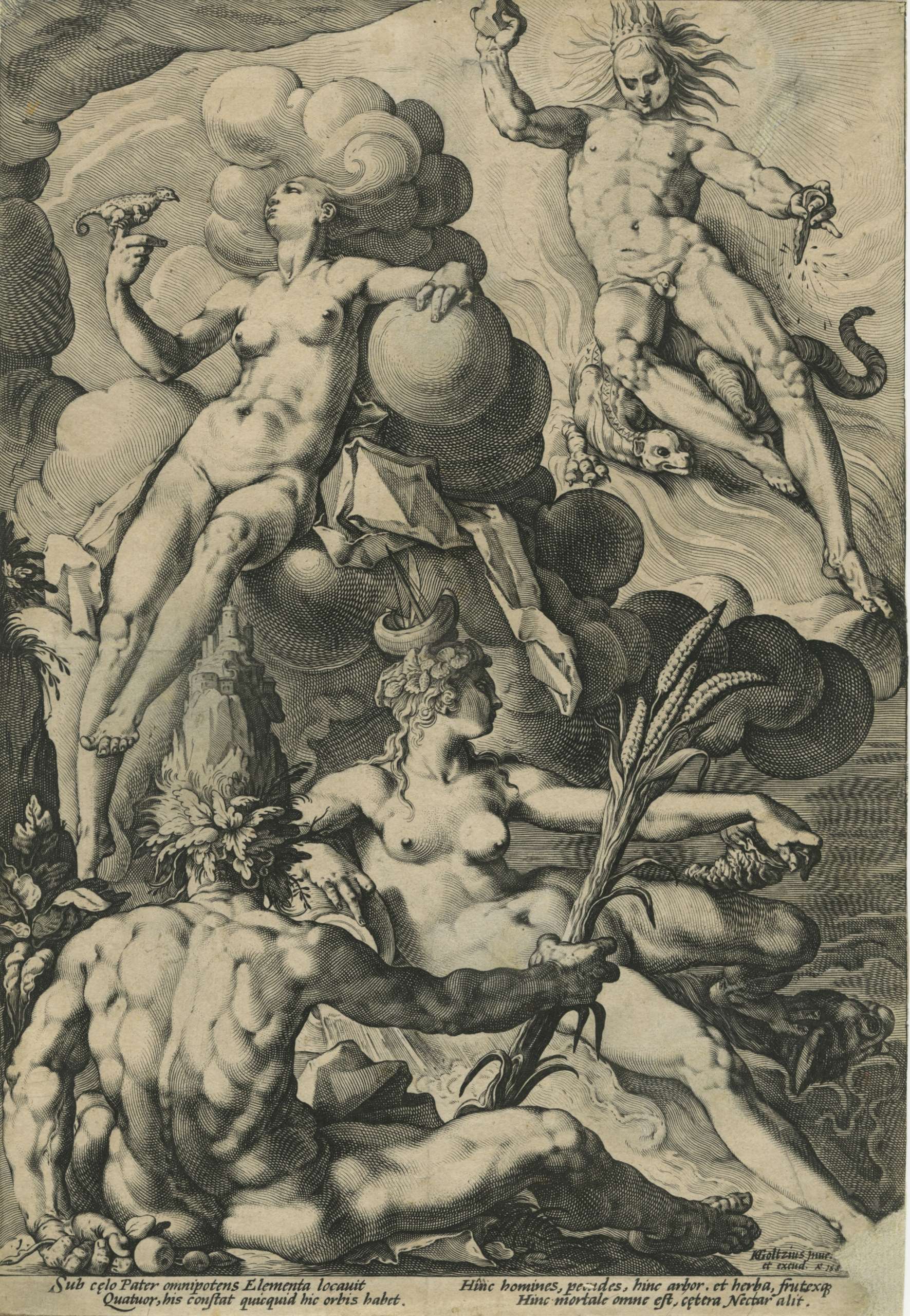
The Four Elements by Jacob Matham (Netherlandish, Haarlem 1571–1631 Haarlem) after Hendrick Goltzius (Netherlandish, Mühlbracht 1558–1617 Haarlem). Engraving on copper, printed on laid paper, 1588.
Dimensions: 298 mm × 206 mm.


